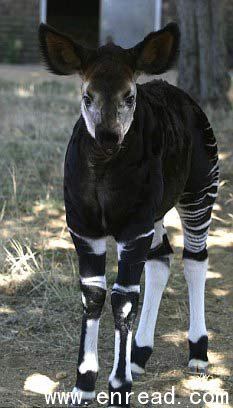三分之一灭绝的哺乳动物其实并未灭绝
Conservationists are overestimating the number of species that have been driven to extinction, scientists have said.
科学家称,环保人士对灭绝物种的数量估计过高。

An okapi: Tracks were seen by researchers five years ago for the first time since 1959.
A study has found that a third of all mammal species declared extinct in the past few centuries have turned up alive and well.
Some of the more reclusive(隐居的) creatures managed to hide from sight for 80 years only to reappear within four years of being officially named extinct in the wild.
The shy okapi(霍加皮) – which resembles a cross between a zebra and a giraffe(长颈鹿) – was first discovered in the Democratic Republic of Congo in 1901.
After increasingly rarer sightings, it vanished from the wildlife radar for decades from 1959, prompting fears that it had died out.
But five years ago researchers working for the WWF found okapi tracks in the wild.
Other mammals 'back from the dead' include the rat-like Cuban solenodon(沟齿鼠) , the Christmas Island shrew, the Vanikoro Flying Fox of the Solomon Islands, the Australian central rock rat and the Talaud Flying Fox of Indonesia.
The revelations come as the world's leading conservationists prepare for a major United Nations summit on biodiversity in Nagoya, Japan, next month.
Many scientists believe the world is going through a new 'mass extinction' fuelled by mankind – and that more species are disappearing now than at any time since the dinosaurs vanished 65 million years ago.
According to the International Union for the Conservation of Nature, 22 per cent of the world's mammals are at risk of extinction. In Britain, more than two plant and animal species are being wiped out each year.